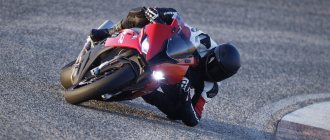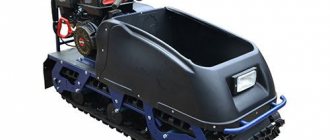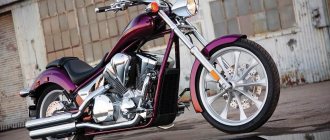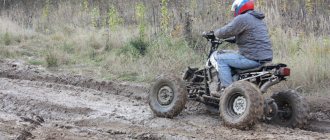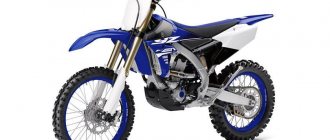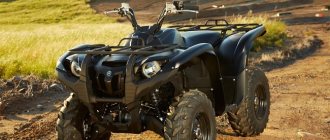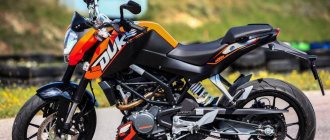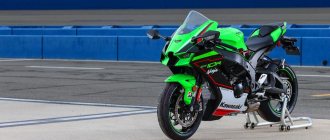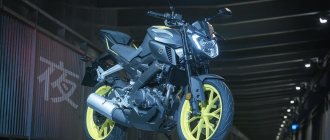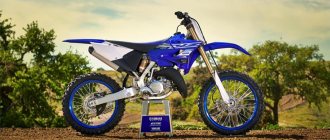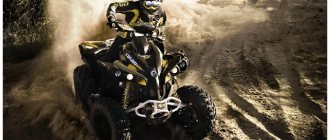RU-MOTO rating
- Reliability
- Chassis
- Appearance
- Comfort
4.5
Verdict
The BMW S1000 RR is a top-end workhorse from the German concern. Regardless of where you see this motorcycle - on video or in real life, it is almost impossible not to pay attention to it.
Read other motorcycle reviews Stels Flame 200 motorcycle review
Do you think that the German automaker only produces top-end cars? This is far from true. The BMW Motorrad motorcycle division is ready to offer a large number of motorcycles that are attractive in terms of characteristics, appearance and price. One such example is the BMW S1000 RR, which we will review below.
External view of the BMW S1000 RR motorcycle
Description
The model began to be mass-produced at the end of 2008, and already in 2009 the first copies entered the market.
The company began producing the second, updated generation of the BMW S1000 RR in 2012.
The latest, currently current version has been in existence since 2015. The third generation was the result of not just a slight restyling, really serious changes were made. The engine was modified and power increased by 6 hp. A suspension equipped with the Dynamic Damping Control system, which was previously installed on the HP4, is installed. An amazing option of the motorcycle is the presence of cruise control, which is not typical for sportbikes.
Read other motorcycle reviews of HONDA CBR1100XX – a fast motorcycle for brave people
Previously, the site Ru-moto.com published a review of the Kawasaki Ninja H2R motorcycle
The friendliness of the new BMW S1000RR
The friendliness of the new BMW S1000RR is the result of BMW Motorrad's hard work during a 46-month development period. The German manufacturer didn’t just want to make an even-faster-litrosport, he wanted to make it lighter and more convenient to control.
Every component of the BMW S1000RR has been put on a strict diet, resulting in a total weight reduction of 11 kg compared to the previous model. BMW says much of the weight reduction comes from the RR's 999cc inline-four engine, thanks largely to a significantly lighter crankshaft, hollow titanium valves and many other modifications. As such, the crankshaft has lost 1.6 kg, significantly reducing the rotating mass in the engine and thus allowing for even easier shifting. A smoother power curve was achieved thanks to BMW ShiftCam technology, which changes the timing of the intake valves at 9000 rpm, thereby ensuring optimal power throughout the entire rev range. As a result, the developers achieved a significant increase in traction at low and medium speeds, while managing to add several “horses” of peak power, reaching 205 hp. at 13500 rpm .
The traction control of the BMW S1000RR is taken care of by a set of on-board electronics, which now provides four riding modes: Rain, Road, Dynamic and Racing. Each mode is a set of factory presets: Throttle response, traction control, wheelie control, engine braking, semi-active suspension and ABS are configured together, without the ability to change the characteristics of each individually.
But this is stock, and for a more professional interaction with the motorcycle, Race or M packages are available, unlocking additional racing modes. In professional racing modes, every parameter can be precisely adjusted to the rider's needs.
BMW S1000RR 2020
Chassis and handling 2020 BMW S1000RR
The new, narrower, lighter chassis also improves handling, with a number of modifications designed to make it easier to shift. The main improvement to the chassis is a lowered swingarm, based on BMW's World Superbike developments. The rear shock absorber mounting point of the new swingarm is located further from the engine, which reduces the negative effect of heat on the operation of the shock absorber damper and reduces the lateral load from the swingarm pivot axis to the wheel axis. This improves steering when accelerating, such as on one of the Estoril - Parabolica sections.
Test
The BMW S1000RR I tested was equipped with the M package, which includes fully customizable professional racing modes, carbon wheels from the exotic HP4 Race, a lightweight battery and premium Motorsport paint. Overall, the M package reduces weight by a further 3.5kg, bringing it to 193kg curb weight. The day started with two 15-minute sessions on stock Bridgestone S21 tires, followed by three more sessions on Bridgestone V02 slicks.
I felt right at home in the saddle: the slightly higher seat allows for more precise control of weight distribution, as well as adding legroom and comfortable foot support for quick shifts. Wide clip-ons increase leverage without causing wrist discomfort when braking, and the tank has a comfortable fit around your knees.
Look into the turn, press on the outer step and the inner handlebar - and the BMW S1000RR is already where it needs to be.
In corners, the bike inspires complete composure from entry to exit due to how stable it holds its line. The rear wheel wobble inherent in the previous model in high acceleration zones is gone, and in its place is a feeling of calm and confidence when opening the throttle. The new chassis gives a complete feeling of reliability in almost all areas of the track, minus a slight lack of information when braking at the entrance to a turn. I played around with the Marzocchi fork settings throughout the day, but in the end I was completely comfortable with just the slicks.
I believe a softer fork spring would give the fork a more consistent compression response when cornering.
BMW S1000RR 2020 test
After playing around with the engine braking modes, I expanded my cornering capabilities a bit. I chose the second level of the three to load the front tire more when braking without slowing the bike too much before the apex of the turn. The first level of engine braking slows down weaker, so there is a possibility that you will have to nervously brake with the front circuit at the last moment so as not to overshoot the apex.
The knee-to-knee shift is where the new BMW S1000RR shines. The combination of reduced weight and significantly less gyroscopic effect from the lightweight crankshaft and carbon rims requires much less body steering effort to shift the bike. Our muscles thank you, BMW.
On aggressive corner exits, you also feel how much better the new model has become. Thanks to more precise throttle control and improvements in traction and wheelie control, the bike works on your side rather than fighting against you like the previous model. In the basic configuration there are 4 traction control settings available, Rain, Road, Dynamic and Race, and in the Professional Racing mode package there are 15 settings available for each - with +7 being the most intervention and -7 the least. I started my first run on slicks in Race mode with the adjustment set to +2 and gradually reduced the level of intervention using the control on the left console. I settled on -3, which is where the traction control in a corner counteracts sideways drift while allowing you to move forward as efficiently as possible.
BMW S1000RR 2020
Electronics BMW S1000RR
The development of traction is impressively linear, even in the most aggressive driving mode with low traction from 5000 rpm. The revs rise quickly, with a noticeable but comfortable lift at 11700. The first level of wheelie control allows you to lift the front wheel slightly in MotoGP style. Thrust builds powerfully right up to the redline, where clutchless shifting allows the BMW S1000RR to continue accelerating at full speed. Quickshifter delays have been significantly reduced.
The ancestor of the S1000RR was notorious for being sluggish when shifting up, but here developments based on the BMW HP4 Race made it possible to increase acceleration without the slightest jerk.
Setting interface
The precision and predictability of the BMW S1000RR's electronics have indeed improved, but menu navigation has not. It's counter-intuitive and time-consuming, and it's terrible to navigate because you have to press a rocker to enter a menu, and to select a specific item you use a large scroll wheel, and if you press it just a little wrong, it will jump to another item and will go into it. While driving, only traction control settings and changing driving modes in general are available, that is, engine braking and gas response cannot be adjusted on the go.
It's sad to see that the BMW S1000RR electronics have come so far, but have not acquired a convenient configuration interface.
BMW S1000RR 2020
But despite a couple of hiccups, BMW has actually managed to make the S1000RR a much friendlier model. More linear traction, a stable chassis and superior performance electronic aids allow you to focus on riding technique, achieving more speed with less effort.
Specifications
We invite you to look at the technical characteristics of the third, currently latest generation:
- engine - 999 cm 3, 199 horsepower;
- suspension - with DDC system, providing dynamic damping control;
- weight - 204 kg fully equipped;
- clutch: multi-disc type, located in an oil bath;
- gearbox - 6 speeds;
- drive - via a lightweight chain;
- maximum speed - 315 km/h;
- fuel supply system - electronic injection, controlled by the engine ECU;
- tank - main (17.5 l) and reserve (4 l);
- Braking system: front with two discs and four-piston calipers, rear with one disc and single-piston floating caliper.
Price
At the moment, only the third generation of the BMW S1000RR is being produced, the price of which is $20,900. For the second generation model you will have to pay about 10-13 thousand dollars on the secondary market. The first generation BMW S1000RR is valued at 7,500-10,000 thousand dollars, depending on condition and tuning.
Screenshot No. 1. Review of prices for used BMW S1000 RR motorcycles on Avito
First variable cam technology on a superbike
bmw s1000rr specifications –
BMW debuted ShiftCam technology on their yet-to-be-released R1250GS, and launch reports suggest it's the system of choice. In principle, it works similarly to Honda's V-Tec system, in which different cams with different profiles are engaged at certain rpms, offering a better powerband across all rpms, but if 1250 is what you're looking for, then that's a whole different story.
First, the cam shift does not occur at a predetermined rpm point, but rather the electronics work out the best point to shift the cams based on various conditions such as rpm, gear, throttle, speed and conditions. Plus, the shift is completely unnoticeable and the only response is more usable power everywhere.
BMW S1000RR, bmw s1000rr specifications
Tuning
The first thing that comes to mind as a modification to a motorcycle of this class is the installation of a direct-flow exhaust. Everything related to appearance tuning is an individual matter. The motorcycle itself has an outstanding appearance, and it is rare to find those who want to significantly change its appearance. But replacing handles, levers, mirrors and similar accessories is common.
BMW S1000 RR tuning option
Among the technical changes, an exclusive piston, connecting rods, exhaust system (Akrapovic leads the way, this is already a tradition), as well as a fuel pump are used to increase power to 300+ horsepower. And this is without taking into account a number of electronic modifications to make it all work really smoothly. The most desperate ones install a turbocharger on a stock engine, although this practice has not yet gained popularity in wide circles.
